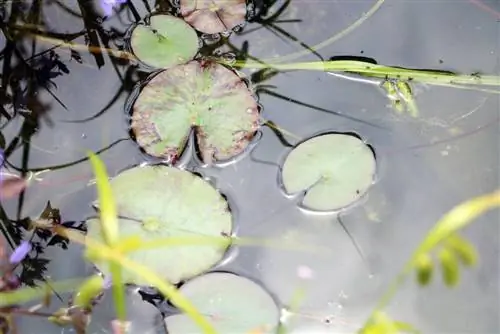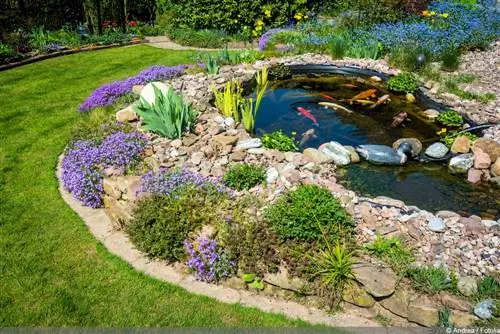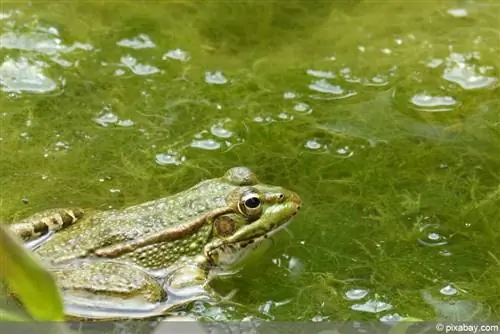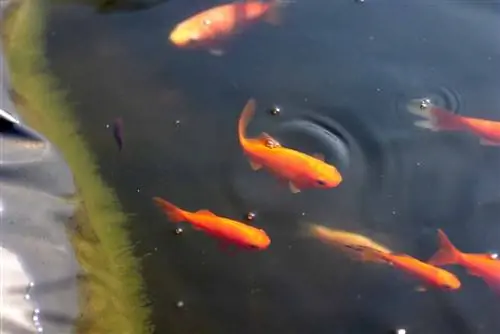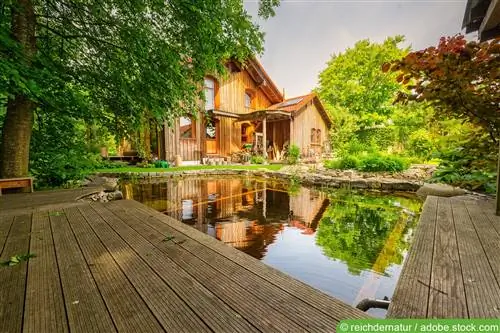- Author admin [email protected].
- Public 2023-12-17 03:39.
- Last modified 2025-01-24 12:45.
In order to find out whether the fluctuations are normal or something is wrong, you have to look into the topic in more detail.
What influences are there on the water level in the pond?
- Water temperature
- Air temperature
- Wind speed
- Wave formation
- Air pressure
- Planting
- Transpiration of plants
- Consistency and material of the riparian zones
Not all of these values can be measured by the layperson, which means that no clear statement can be made about their influence on the water level.
Water level fluctuations according to the German Weather Service
According to the German Weather Service, fluctuations of 1mm 1 liter per m² per month are normal. For a medium-sized pond 2 m deep, this means that around 140 liters of water evaporate per month in July. In April it is only half that, but the temperatures are lower and the sun is not as strong. However, evaporation is higher in lower ponds. In any case, the evaporation should not be serious. If there is a lack of sufficient water on a regular basis, there are usually other reasons.
What to do if you lose water in the pond?
It is completely normal that the water level drops in summer. This is because the sun and heat cause some of the water to simply evaporate and the plants also need more water. Especially in shallow water zones, a lot of water “disappears”. But there are also other causes for water loss.
Causes of water loss
If there is a regular lack of water in the pond, even in cool and damp weather, there may be other reasons. A hole in the pond liner is just one possibility. Fortunately, this suspicion is rarely confirmed. However, a missing capillary barrier is more often the reason for water loss. Water is therefore absorbed into the soil outside the pond. Depending on the size of the pond, that can be a lot of water that disappears never to be seen again.
- Weather influences
- Hole in the pond liner
- Missing capillary barrier
- Fountains and streams
- Hoses, pipes and technology
Hole in the pond liner
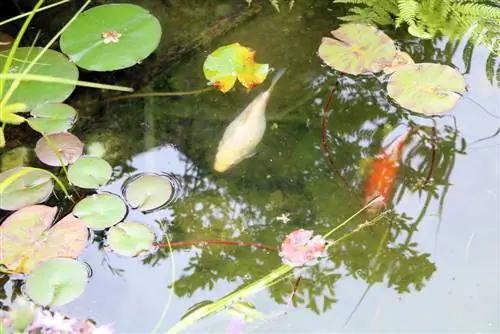
The most difficult thing about a leak in the pond liner is finding the leak. There are some useful ways to find this. The pond water is drained in stages. If more water still disappears, the hole is deeper and you have to let the next stage out. Otherwise the pond can be filled to capacity. Every day the water level is marked with a chalk line. When the level stops falling, the water depth at which the hole is located has been reached. You then have to search specifically at this height. Cracks in the upper area of the film can be repaired quite easily. The area around the leak must be cleaned carefully but thoroughly. A new piece of pond liner is glued on there using special glue. This should be very generous in size, protruding at least 5 cm on each side. Depending on the manufacturer's instructions, the glue must dry, which can take one or even several days. The pond is then filled again. However, if the hole is very deep in the pond, repairs will be difficult. Most of the time the plants and fish have to be removed from the pond and if you are unlucky also the gravel and stones that cover the bottom. All water must be drained. It involves a lot of effort. Individual small areas can be repaired with “patches”. But if there are too many, there are cracks or the film has even become brittle, it is better to replace it completely.
Tip:
PVC pond liners can be repaired quite easily as just described. With rubber films (EPDM) it is a little more complex because different adhesives are used. The film must first be treated with a special basic cleaner. An adhesive is then applied to the dry rubber film. This is followed later by double-sided, permanently elastic tape, which must be specifically suitable for connecting EPDM. The prepared foil patch goes onto this well-prepared adhesive point. It must be pressed firmly, preferably with a heavy rolling pin or a wallpaper roller.
- PVC film has a lifespan of 10 to 15 years
- A rubber film lasts longer, 25 years and more
Missing capillary barrier
The capillaries in the soil have a suction effect on the pond water. Similar to plant roots that spread out in all directions, they stretch towards the water and exert a suction. Although it helps to cut the plant roots and reduce the soil a little, this is usually not a permanent solution. Soil, stones and plant roots can draw water out of the pond from outside over the edge of the pond, sometimes considerable amounts. The edge of the pond usually has to be completely rebuilt or a functioning capillary barrier has to be installed. The easiest way to achieve this is to pull up the edge of the pond liner. You push them over a small earthen wall and bury them behind it again. This creates clean edges and everything looks very neat. Slope mats additionally protect the bank from tearing of the film due to tensile stress or UV radiation.
- Suction effect on the pond water
- Bank mats, plant bags and stone foil can cause water loss if they do not end within the foil seal
- Install capillary barrier
Fountains and streams
Fountains or streams can also be the cause of water loss in the pond, especially in strong winds. The wind carries the water drop by drop into the edge area or out of the pond area. If this continues for many hours, a lot of water will accumulate and disappear.
hoses, pipes, taps or valves leaking
Technology and supply lines can also be to blame if a pond constantly loses water. The only thing that helps here is to check everything, i.e. all hoses, pipes, supply lines, taps, slide valves and the like. The leak must be found. Particularly inexpensive water hoses do not last particularly long and have to be replaced frequently. First, all pumps should be turned off. The water level must be monitored below. If it stays at the same level, the connections need to be checked. All technology must be checked.
Plants
Plants can also damage a pond, especially the pond liner. This can happen from the outside and from the inside. Plants that form strong, pointed runners are not suitable for pond edges. These mainly include bamboo and reed species. If you still want to plant these plants there, you have to put a rhizome barrier of at least 80 cm around it or at least along the pond. In the pond, pond reeds are dangerous for the films. It should generally only be placed in the pond in a stable and closed container. In addition, growth must be checked frequently and regularly. It forms strong runners that pierce the film like cheese. In swamp areas it is often loosestrife that damages the foil, often in the first summer.
Conclusion
If there is a regular lack of water in the garden pond, this can have various causes, from natural evaporation, to a defect in the pond liner, to the withdrawal of plants and soil due to a lack of a capillary barrier. It is important to first find out the cause. In over 90 percent of cases it is the capillary blockage or the lack of it. This is where most of the water is lost. It is often tedious and time-consuming to repair the error. Often the pond owner was simply uninformed or had poor advice and made mistakes when building the pond or planting it. That's why good preparation is particularly important before you put a pond in your garden. Many things can be avoided, which saves money, time and nerves.

